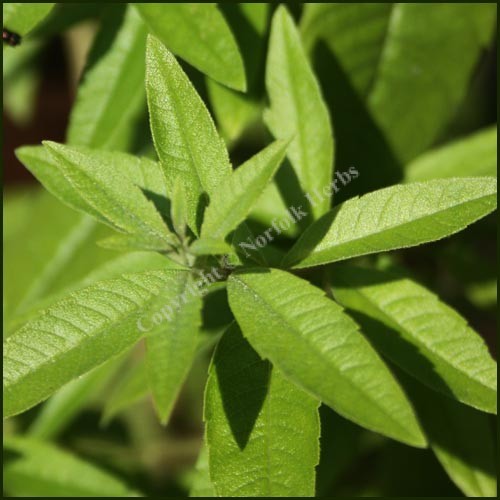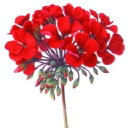Lemon verbena (Aloysia citriodora), also known as lemon beebrush, is a woody perennial shrub from the Verbenaceae family. Native to South America, specifically Bolivia and northwestern Argentina, it was introduced to Europe in the 17th century by Spanish and Portuguese sailors, valued for its fragrant oil.
This plant is well-known for its distinctive lemon scent, which becomes more pronounced when the leaves are bruised. The species name citriodora translates to “lemon-scented,” reflecting its most notable characteristic. Lemon verbena typically blooms in late spring or early summer, though potted specimens may not flower.
With its aromatic qualities and historical significance, lemon verbena continues to be a favorite among gardeners and plant enthusiasts worldwide.
| Common name | Lemon Beebrush Lemon Verbena |
| Botanical name | Aloysia citriodora |
| Family | Verbenaceae |
| Species | citriodora |
| Origin | Bolivia to NW. Argentina |
| Life cycle | Woody |
| Plant type | Annual |
| Hardiness zone | 8, 9, 10 |
| Sunlight | Full Sun |
| Maintenance | Low |
| Soil condition | High Organic Matter |
| Drainage | Well-Drained |
| Flowering period | Fall |
| Height | 2 ft. – 4 ft. |
| Flower color | Lavender, Purple |
| Leaf color | Green |
| Leaf benefit | Fragrant |
| Flower benefit | Fragrant |
| Garden style | Garden for the Blind |
| Uses | Container |
I. Appearance and Characteristics
Aloysia citrodora, lemon verbena, is a species of flowering plant in the verbena family Verbenaceae, native to South America. Other common names include lemon beebrush. It was brought to Europe by the Spanish and the Portuguese in the 17th century and cultivated for its oil.
Lemon verbena is a perennial shrub or subshrub growing to 2–3 metres (7–10 ft) high. The 8-centimetre-long (3 in), glossy, pointed leaves are slightly rough to the touch and emit a strong lemon scent when bruised (hence the Latin specific epithet citrodora—lemon-scented).

Sprays of tiny purple or white flowers appear in late spring or early summer, although potted lemon verbenas may not flower. It is evergreen in tropical locations, but is sensitive to cold, losing leaves at temperatures below 0 °C (32 °F), although the wood is hardy to −10 °C (14 °F). Pruning is recommended in spring to encourage a bushy form. Due to its many culinary uses, it is widely listed and marketed as a plant for the herb garden.
II. How to Grow and Care
Sunlight
Lemon verbena needs full sun six to eight hours per day, which is typical for a vegetable garden. Plants that are grown indoors as houseplants might need supplemental artificial lighting to prevent lanky growth and leaf drop.
Temperature and Humidity
In its native South America, lemon verbena plants grow in a sunny, frost-free climate. Temperatures below 40 degrees Fahrenheit will trigger leaf drop and dormancy. Plants do well in dry or humid environments. Because lemon verbena is sensitive to frost, it might be best to grow it in a container so that you can move the container indoors during the winter.
Watering

Lemon verbena needs regular irrigation. A lack of water leads to plant stress, leaf drop, and insect pest infestation. Keep the surface of the soil moist, but don’t oversaturate the plants; The roots do not like to stay wet. When the top two inches of soil are dry, water and aim for a moisture level that resembles a wrung-out sponge. Plants grown indoors for the winter months can be watered once a week, but may be kept on the dry side.
Soil
Lemon verbena does well in rich garden loam, and it also tolerates average soil. However, good drainage is essential, so if garden bed soil is heavy and dense, plant them in raised beds or containers.
Fertilizing
Unlike other herbs, lemon verbena appreciates a regular fertilizing schedule to keep it lush and vigorous. Feed plants in the spring with an all-purpose fertilizer. Watering with compost or manure tea during the growing season will keep plants productive.
Planting Instructions
Plant lemon verbena alongside other culinary herbs such as dill, basil, parsley, and oregano for a collection of aromatic foliage in your garden. Lemon verbena also goes well in a mixed border alongside blooming annuals and perennials, where it adds interest to the landscape and attracts pollinators and other beneficial insects. Choose a location that receives full sun daily and plant in well-draining soil.

You can also plant lemon verbena in containers outside your backdoor for garden-fresh flavor steps from the kitchen. The plant stays smaller in a container, which is a good way to grow lemon verbena in a small space.
Set out plants in the spring after the last spring frost. You can start lemon verbena from seed, but seeds have a low germination rate and are slow to sprout and grow. The fastest and easiest way to grow lemon verbena is with a starter plant from a nursery. Plant it in a prepared bed of rich, well-draining soil at the same depth it was in its nursery container.
To grow lemon verbena indoors in the winter, keep it by a bright, sunny window indoors and water it regularly.
How to Grow in Pots
Growing lemon verbena in a container is ideal for cultivating the plant all year in colder regions; Container-grown lemon verbena also stays a more manageable size than plants grown in the ground.
Choose a container of any material, but double the size of the plant’s root ball. The pot should have numerous drainage holes. Add loose potting soil enriched with time-release fertilizer, leaf mold, or compost to ensure a healthy start. Keep the container in full sun, water daily, offer a general fertilizer every few months, and if the pot is outdoors, overwinter it indoors once the temperatures drop to 40 degrees Fahrenheit.
Pruning
Lemon verbena growing in containers rarely exceeds two or three feet tall, but the shrubs can exceed eight feet outdoors in frost-free climates. Over time, the shrubs can get woody, lanky, and they generally can look worn out. Cut plants back by a third to half in early spring to encourage compact, bushier, and thicker growth.
Propagation
If you love the aroma of lemon around your property, propagating lemon verbena from an existing bush will provide more opportunities to enjoy its fragrance. If you are an avid user of its leaves for potpourri, tea, or other recipes, you can save money cultivating your own supply instead of buying pricy leaves from a retailer.

Lemon verbena is propagated in the same way as other woody herbs like rosemary and lavender—by taking semi-ripe cuttings in the summer.
- With a sterile and sharp cutting tool, snip a four- to six-inch flower-free stem above a leaf node. The stem should be about 1/4 inch in diameter. Remove all but the top two sets of leaves.
- Insert the cutting one inch deep into a moist, sterile potting mix. (Rooting hormone is not necessary, but you can use it if you prefer.)
- Provide the cutting with a humid environment by placing the pot in a large clear plastic bag that is closed at the bottom. Make a one-inch nick at the top so moisture can escape.
- Check the plant every other day by removing the bag to see if the soil surface is dry. If it is dry, add a light watering to moisten the soil. Lightly mist the cutting and the leaves if they feel dry.
- After a few weeks, begin to gently tug on the plant to see if roots have developed. Once you feel resistance, take off the plastic bag and continue growing the plant indoors for two more weeks.
- Transplant the cuttings into a four-inch container placed in the sun until it’s time to plant cuttings in their permanent outdoor site in the spring.
Potting and Repotting
When grown in a container, lemon verbena stays 2–3 feet tall. Select a container with drain holes and fill it with well-draining garden soil or potting soil. Lemon verbena can live in a sunny spot most of the year, but it must be brought in for the winter or frost kills it. Inside, position the plant where it receives as much sunlight as possible. Instead of repotting each year, trim the plant by a third to keep the size manageable. When you do repot, use fresh soil.
Overwintering
Lemon verbena usually drops its leaves and enters dormancy when the temperature drops lower than 40 degrees Fahrenheit. Help plants prepare for winter by reducing watering a few weeks before the typical onset of cooler temperatures. Provide extra winter protection by cutting plants back to within a couple of inches from the ground after the first hard frost and covering the remaining stub with soil. Cover the soil with a four- to five-inch layer of mulch
Bring your potted lemon verbena plant indoors or to a greenhouse when temperatures drop below 40 degrees Fahrenheit. Potted plants moving indoors for the winter will typically lose leaves. A grow light may prevent leaf loss, but it is not necessary.
Pests and Diseases

Lemon verbena growing outdoors in full sun and rich soil is rarely plagued by pests. When brought indoors to overwinter, spider mites and whiteflies seem to be drawn to the plants as they struggle to acclimate to weaker light and less humidity. Mist plants frequently to disrupt the dry conditions that spider mites enjoy. Put out yellow sticky traps if whiteflies congregate.
III. Uses and Benefits
- Medicinal uses
It is used in traditional medicine in Latin American countries. The oil was historically steam-distilled from the leaves for use in the perfume industry, but it has skin-sensitising and phototoxic properties. In the European Union, verbena essential oils (Lippia citriodora Kunth.) and derivatives other than absolute are prohibited when used as a fragrance ingredient.
- Culinary uses
Lemon verbena leaves are used to add a lemon flavor to fish and poultry dishes, vegetable marinades, salad dressings, jams, puddings, Greek yogurt, and beverages. The leaves are also used in potpourri. Lemon verbena is used to make herbal teas and as a liqueur flavoring.
When it comes to lemon-scented herbs, lemon verbena has the most intense oil concentration per square inch of plant material. This plant is beloved as an additive to drinks, baked goods, or anywhere you might use lemon zest, and it’s not bitter.
IV. Harvesting and Storage

Harvest leaves once the plant reaches at least ten inches tall and has multiple leaves on each stem. When lemon verbena flowers, the leaves are at their most flavorful. But refrain from simply plucking the leaves off a stem; The stem needs to be cut back to within 1/4 of a leaf or node. Remove no more than 1/4 of the stem when harvesting so that the plant can continue growing.
Because the leaves are tough, you must mince them finely if you plan to consume them. You can also infuse sauces, oil, sugar, or tea with whole leaves. The tiny blossoms of lemon verbena also carry a heady scent and can be used in the same way as the leaves.
Find Where to Buy the Best Lemon Verbena (Aloysia citriodora)


















Leave a Reply